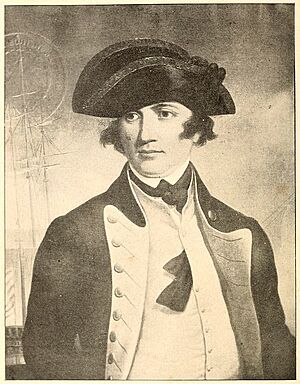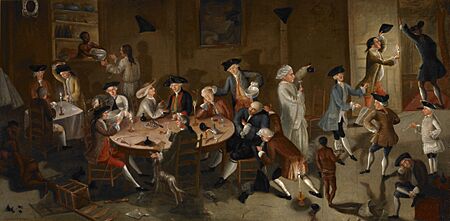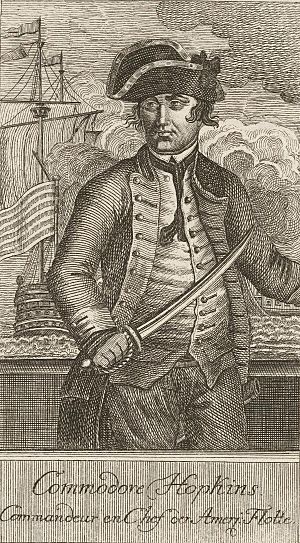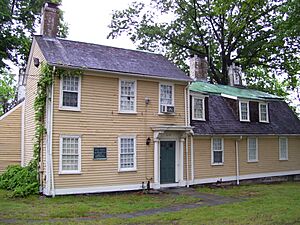Esek Hopkins facts for kids
Quick facts for kids
Esek Hopkins
|
|
|---|---|
 |
|
| Born | April 26, 1718 Scituate, Colony of Rhode Island and Providence Plantations |
| Died | February 26, 1802 (aged 83) Providence, Rhode Island |
| Buried |
North Burial Ground,
Providence |
| Allegiance | |
| Service/ |
Privateer |
| Years of service | 1754–1763 (privateer) 1775–1778 (Continental Navy) |
| Rank | Captain (Privateer) |
| Battles/wars | French and Indian War American Revolutionary War |
| Spouse(s) | Desire Burroughs |
| Signature |  |
Esek Hopkins (born April 26, 1718 – died February 26, 1802) was an American naval officer. He was also a merchant captain and a privateer, which means he commanded private ships that attacked enemy ships during wartime. Hopkins became a Commodore, a high rank in the navy. He was the only Commander-in-Chief of the Continental Navy during the American Revolutionary War. The Continental Congress made him Commander-in-Chief in December 1775.
He is well-known for his successful attack on the British port of Nassau in the The Bahamas. During this attack, he captured many military supplies. Today, his legacy is debated because he was involved in the Trans-Atlantic slave trade.
Contents
Early Life and Career
Esek Hopkins was born in Scituate, in the Colony of Rhode Island and Providence Plantations. His family was very important in what is now Rhode Island. When he was twenty, he started working at sea. He quickly became known as a skilled sailor and trader.
Before the Revolutionary War, he had sailed to many parts of the world. He also commanded a privateer ship during the French and Indian War. When he was not sailing, he was involved in Rhode Island politics. He served as a deputy in the Rhode Island General Assembly. He also strongly supported his brother Stephen, who became governor in 1755.
In September 1764, Hopkins took command of a slave ship called Sally. This ship was owned by Nicholas Brown and Company. Hopkins had no experience with slave trading ships before this. The 15-month journey was very difficult. Sadly, 109 out of 196 enslaved people died during the voyage. In late 1765, Sally reached its first trading stop. However, the enslaved Africans who survived were in such poor health that they sold for very little money. Hopkins' difficult command of Sally later made Moses Brown turn against the Atlantic slave trade.
Revolutionary War Service
Leading Rhode Island's Military
On October 4, 1775, Hopkins was made a brigadier general. This meant he commanded all military forces in Rhode Island. He immediately started to make Rhode Island's defenses stronger. He had help from his deputy, William West.
Becoming Commander-in-Chief
A few months later, on December 22, 1775, Hopkins received an important appointment. He was named Commander-in-Chief of the Continental Navy. The Continental Congress gave him this role to protect American trade. On January 5, 1776, Congress gave Hopkins his specific orders. These orders told him to sail his fleet to Chesapeake Bay in Virginia. There, he was to attack and destroy any British naval forces. If successful, he was then to go south to North and South Carolina. He was to attack enemy forces there too. However, the orders also said that if bad weather or other problems stopped him, he should do what he thought was best. His goal was to help the American cause and harm the enemy.
The First Fleet Operation: Raid of Nassau
Hopkins took command of eight small merchant ships. These ships had been changed into warships in Philadelphia. He thought carefully about fighting the strong British forces mentioned in his orders. Instead, he decided to use the last part of his orders. On February 17, 1776, he sailed south. This was the first operation for the U.S. fleet. He took the fleet to Providence in the Bahamas. He believed it would be better to capture valuable supplies for the Continental Army. He did not want to risk destroying the new Continental Navy. He knew the British port in Nassau would not be well-guarded. He also had friends there who would help him.
The Raid of Nassau happened on March 3, 1776. It was an attack on the British colony there. This was also the first time U.S. forces landed from the sea. Marines and sailors landed and captured weapons. These weapons were badly needed for the War of Independence. The small fleet returned to New London on April 8, 1776. They had also captured two British merchant ships and a six-gun schooner. They tried to capture HMS Glasgow on April 6 but only damaged it.
John Hancock, who was President of the Continental Congress, wrote to Hopkins. He congratulated Hopkins on his successful trip. He said that Congress was very happy with the bravery shown by the men. Hopkins' expedition brought needed war supplies to the Continental Army. It also showed the British Navy that they would have to send ships to protect other areas. This meant fewer British ships could fight in the main war zones. John Paul Jones was a lieutenant under Hopkins at this time.
Challenges and Dismissal
Hopkins' choice to go to Nassau instead of Chesapeake Bay upset some members of the Continental Congress. These members were from the southern states. This added to the disagreements already happening among Congress members.
What happened next was complicated. The Continental Congress and state governors allowed private ships to help fight Britain. They did this by giving out letters of marque. Thousands of these privateer ships attacked British ships. They helped the war effort at sea. These privateer ships could keep anything they captured from British ships. This meant they could pay their sailors and officers almost twice as much as the Continental Navy. The Continental Navy had to give everything they captured to the colonies. Even after Congress built more ships for Commodore Hopkins, he could not find enough people to work on them. Important figures like John Adams, Samuel Adams, Benjamin Franklin, Richard Henry Lee, Robert Treat Paine, and John Paul Jones defended Hopkins.
However, on August 12, 1776, Congress criticized Hopkins. This caused him great embarrassment and hurt his reputation. Many people say it would have been better if Hopkins had been removed from command then. Instead, he continued with a damaged reputation and less respect from his officers. Still, soon after, John Hancock suggested naming a warship after Hopkins. However, there are no records that this actually happened.
Hopkins' small fleet was mostly trapped in Narragansett Bay. This was because the British had a much stronger navy. Also, Hopkins did not have enough men to fight the enemy. A group of Hopkins' officers went directly to Congress without permission. Later, it was found that their complaints against Hopkins were not true. But it was too late to stop what was happening. People started to question Hopkins' character and ability more and more. Even though John Hancock had praised Hopkins, his decision to go to Nassau and the escape of the Glasgow were used against him by politicians.
Even with John Adams' strong defense, the Continental Congress voted on January 2, 1778, to remove Hopkins from his command permanently. However, Hopkins' first action in Nassau later proved to be a smart way for the Continental Navy to fight the much larger British Navy. John Paul Jones, who had served under Hopkins, gained great respect by using this same type of naval warfare against the Royal Navy. The Raid on Nassau also made the British worry about their important trade areas in the West Indies. This worry often made them send ships away from the American colonies. This might have even helped America win the war in the long run. So, the Raid of Nassau was not just a small victory, but a very important strategic one.
Hopkins' role as Commander-in-Chief ended on January 2, 1778.
Life After the Revolution
Even though Congress dismissed him, Hopkins was highly respected in Rhode Island. He continued to serve in the Rhode Island General Assembly until 1786. After that, he retired to his farm. He died on February 26, 1802. His home, the Esek Hopkins House, is now listed as a historic place.
Legacy and Recognition

Three United States Navy ships have been named USS Hopkins in his honor. These include two destroyers and a patrol boat.
A statue of Hopkins was put up in 1891. It was made by Theo Alice Ruggles Kitson. The statue is in Hopkins Square, Providence, where the Hopkins family cemetery used to be.
In June 2020, the Providence School Board voted to change the name of Esek Hopkins Middle School. They did this because of Hopkins' connection to the slave ship Sally.
Hopkins helped make the "Gadsden flag" popular. This flag shows a rattlesnake with 13 rattles, representing the 13 Colonies. It has the words "Don't Tread on Me" on a yellow background. He used this flag as his personal flag. He flew it from the main mast of his main ship, the USS Alfred, when he was on board.
Personal Life
Hopkins married Desire Burroughs (1724–1794) in November 1741. She came from a wealthy family in Newport. This helped increase his influence in Rhode Island. They had nine children. One of their children was John Burroughs Hopkins (1742–1796). He was involved in the Gaspee Affair and later became a captain in the Continental Navy. Another child was Susannah Hopkins (1756–1850). She married Jonathan Maxcy, a minister and the second president of Brown University.
Esek Hopkins was the brother of Rhode Island governor Stephen Hopkins. Stephen Hopkins signed the Declaration of Independence. He was also the first chancellor of Brown University.
Hopkins was buried in the North Burial Ground in Providence, Rhode Island.
See also
 In Spanish: Esek Hopkins para niños
In Spanish: Esek Hopkins para niños




